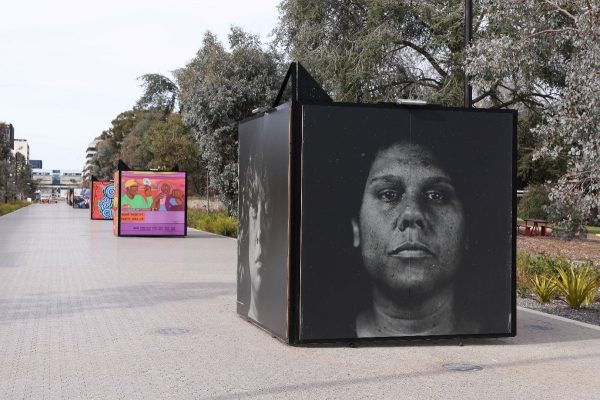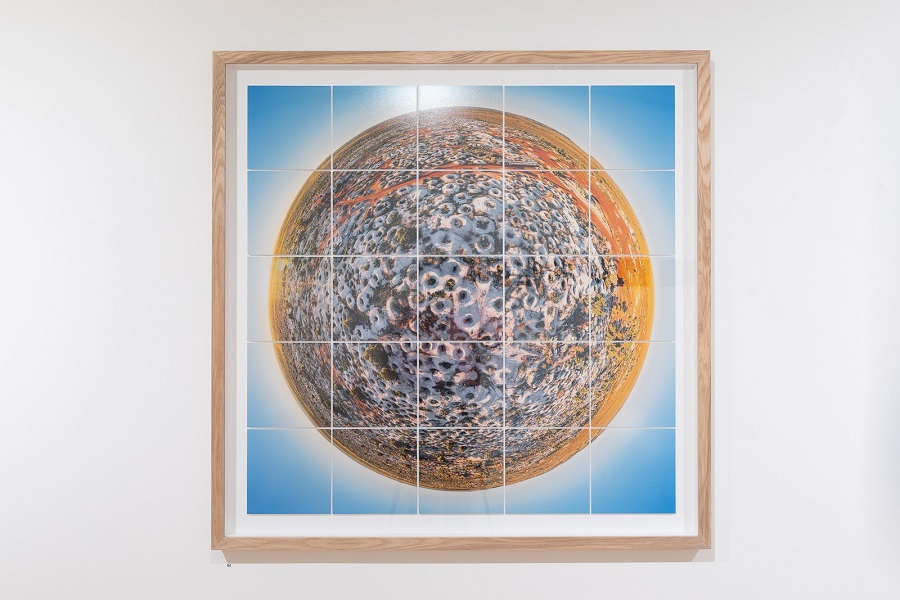
Photography / “While You Were Asleep: 2”. Along Exhibition Avenue, Kambri precinct, ANU, until July 31. Reviewed by CON BOEKEL.
THE exhibition consists of works by 12 indigenous artists. Based on various media, the works are presented as very large scale prints. The latter are mounted on large boxes which, in turn, are in a row along Exhibition Avenue at the ANU.
Some of the artists are instantly recognisable: Blak Douglas is the winner of this year’s Archibald Prize; Brenda L Croft is a well-known Canberra artist.
All the images are intended to convey messages. Of these, the most consistent address issues around identity and the sense of belonging to country. Admirers of Jane Austen would recognise her use of “country”. There is some overlap in the intimate sense of belonging to place.
There is deep anger at the misrepresentation of history and at the contemporary treatment of indigenous peoples, particularly Aboriginal deaths in custody – around 500 men, women and children since 1991.
There is also a sense of serene belonging, as in Nadurna’s story about travelling through country and of how country nurtures the traveller.
There is overt and implicit pride. The overt pride is displayed in the beautiful and evocative contemporary portraits of indigenous women in honour of Barangaroo by Croft. The implicit pride comes through in the effortless use of indigenous symbolism – the concentric circles for waterholes/campgrounds and the dotted lines for the tracks connecting them. What is most striking is the creativity with which this millennia-old symbolism is used and redeployed to this very day.
The art is seamlessly both personal and political. As per the title, the exhibition is intended as a wake-up call. It gives artistic expression to the drivers for the Statement from the Heart.
Going specifically to the photographic images, the quality is excellent. It ranges from street photography of scenes of protests, through photographs which have been digitally altered using post-processing algorithms, through classic photographic portraiture, to clever plays on photographic “realist” images which turn out to be of carefully staged scenes.
The large scale of the prints generates power. It is well worth the effort to move near and far when viewing this exhibition. Close up, the prints dwarf the viewer. Seen from afar, they tend to blend into the ANU landscape. Grasping the full range of meanings partially depends on distance and hence on the changing landscape context of the imagery.
Looking west along the exhibition, Black Mountain fills the frame and reflects some of the stories embedded in the exhibition. In 1823 Joshua John Moore took land where Black Mountain then met the Molongolo River. It is fitting that Ngunnawal and Ngambri people, traditional owners, are actively involved in the management and care of the mountain.
This exhibition is well worth a visit. It offers creativity, deep emotion, truth and connection at very many levels.
Who can be trusted?
In a world of spin and confusion, there’s never been a more important time to support independent journalism in Canberra.
If you trust our work online and want to enforce the power of independent voices, I invite you to make a small contribution.
Every dollar of support is invested back into our journalism to help keep citynews.com.au strong and free.
Thank you,
Ian Meikle, editor




Leave a Reply